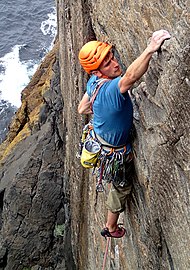| Part of a series on |
| Climbing |
|---|
 |
| Lists |
| Types of rock climbing |
| Types of mountaineering |
| Other types |
| Key actions |
| Key terms |
Free climbing is a form of rock climbing in which the climber can only use climbing equipment for climbing protection, but not as an aid to help in their progression in ascending the route.[1][2] Free climbing, therefore, cannot use any of the tools that are used in aid climbing to help overcome the obstacles encountered while ascending a route. The development of free climbing was an important moment in the history of rock climbing, including the concept and definition of what determined a first free ascent (or FFA) of a route by a climber.
Free climbing can be performed in several formats depending on the type of climbing protection used, including traditional climbing (uses temporary removable protection), sport climbing (uses permanently fixed in-situ protection), and bouldering and free solo climbing (uses no protection whatsoever).
The free climbing movement was an important development in the history of rock climbing.[3] In 1911, Austrian climber Paul Preuss started what became known as the Mauerhakenstreit (or "piton dispute"), by advocating for a transition to "free climbing" via a series of essays and articles in the German Alpine Journal where he defined "artificial aid" and proposed 6 rules of free climbing including the important rule 4: "The piton is an emergency aid and not the basis of a system of mountaineering".[3][4] In 1913, German climber Rudolf Fehrmann published the second edition of Der Bergsteiger in der Sächsischen Schweiz (or The Climber in Saxon Switzerland), which included the first binding rules for climbing in the area to protect the soft sandstone rock. The rules said that only natural holds were allowed, and these "rules for free climbing" are in still use today.[5]
In 1975, German climber Kurt Albert painted his first "Rotpunkt" (or redpoint) on the base of the aid climb Adolf Rott Ged.-Weg (V+/A1), in the Frankenjura, signifying he had "free climbed" it as a redpoint (i.e. after many failed attempts); the redpoint became the accepted definition of what constituted a "first free ascent".[6][7]
The first "free climb" of a climbing route is known as the first free ascent, or FFA, and is chronicled by climbing journals and guide books. They also chronicle whether the "free climb" was done onsight (i.e. first try without any prior information), flashed (i.e. first try with prior information), or redpointed (i.e. completed after a first failed attempt).[8][9] FFAs that create new grade milestones are important events in climbing history.[10]
The derived term French free climbing, refers to the French lead climbing technique of "pulling upward" on pieces of in-situ climbing protection equipment (e.g. quickdraws on bolted routes or SCLDs on traditional climbing routes), as a source of aid in ascending the climbing route.[11] It is equivalent to an A0-graded aid climbing technique and is typically used on longer big wall climbing or alpine climbing routes where it is important that the climber(s) progress efficiently and not get overly delayed on a specific section.[11]
Despite the name, 'French free climbing' is not considered 'free climbing' per se, and a climber that uses the technique could not claim a 'first free ascent' of a new route.[11]
Free climbing means using no form of artificial or mechanical aid to help progression in ascending a route.[5] Even the act of pulling on the climbing protection equipment as employed in 'French free climbing' (either placed by the climber while climbing or already in situ with pre-placed bolts) is considered aid climbing and carries an aid climbing grade of A0.[12]
Free climbing can be performed in a variety of types of climbing, and most importantly:[13]
Free climbing has been called "rock climbing's most commonly mistaken term", with problems including:[13]
Free climbing is related to, but separate from, the broader climbing topic area of clean climbing; however, clean climbing does not support bolted sport climbing routes on natural rock, and thus external redpointed first free ascents are not advocated.
the sport of climbing on rocks, up mountains, or up walls or buildings using no equipment to help you to climb, only ropes or other safety devices that prevent falling
climbing without using pitons, étriers, etc, as direct aids to ascent, but using ropes, belays, etc, at discretion for security